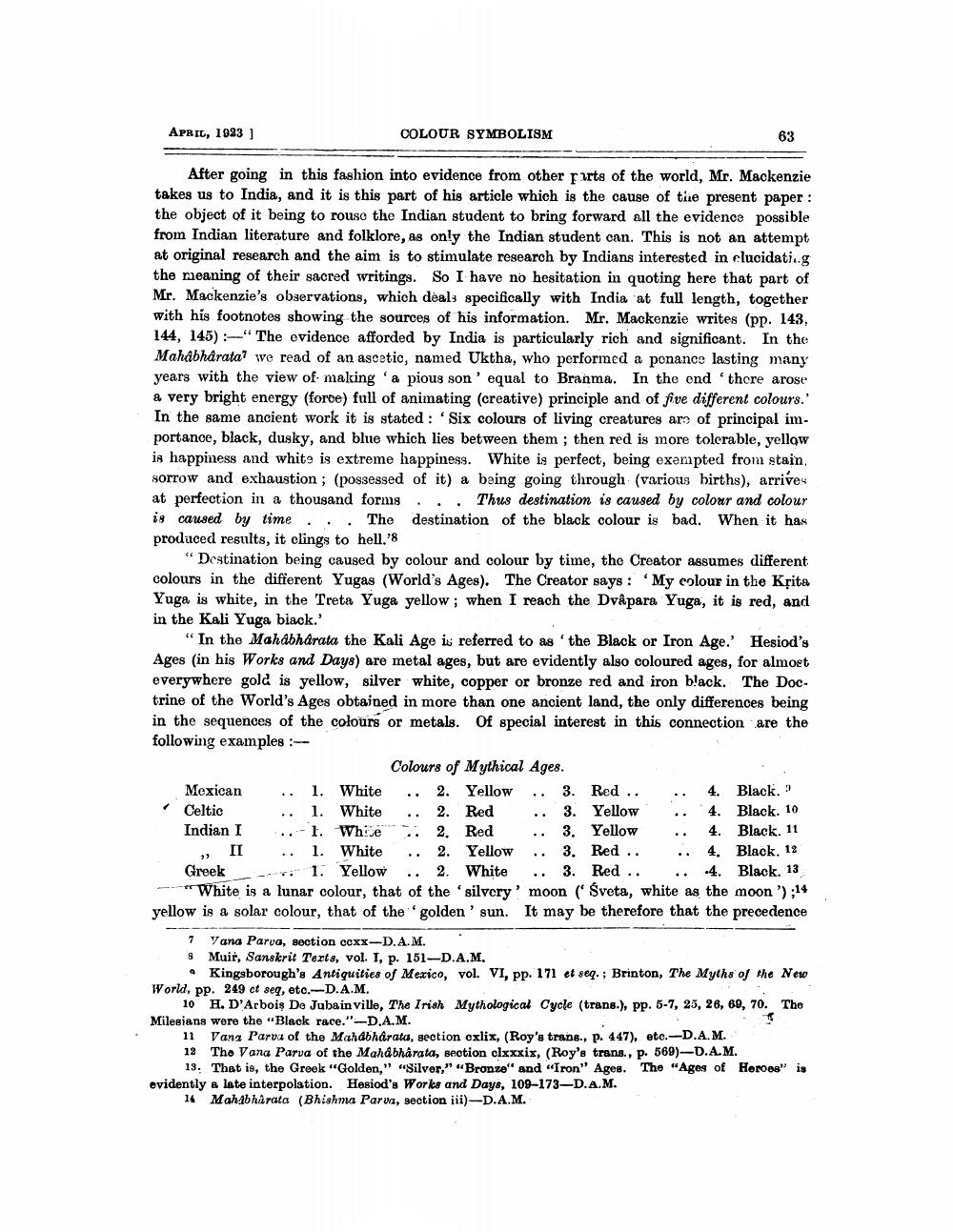________________
APRIL, 1923 ]
COLOUR SYMBOLISM
After going in this fashion into evidence from other parts of the world, Mr. Mackenzie takes us to India, and it is this part of his article which is the cause of the present paper: the object of it being to rouse the Indian student to bring forward all the evidence possible from Indian literature and folklore, as only the Indian student can. This is not an attempt at original research and the aim is to stimulate research by Indians interested in elucidati..g the meaning of their sacred writings. So I have no hesitation in quoting here that part of Mr. Mackenzie's observations, which deals specifically with India at full length, together with his footnotes showing the sources of his information. Mr. Mackenzie writes (pp. 143. 144, 145):-"The evidence afforded by India is particularly rich and significant. In the Mahabharata we read of an ascetic, named Uktha, who performed a ponance lasting many years with the view of making a pious son' equal to Branma. In the end there arose a very bright energy (force) full of animating (creative) principle and of five different colours.' In the same ancient work it is stated: Six colours of living creatures are of principal importance, black, dusky, and blue which lies between them; then red is more tolerable, yellow is happiness and white is extreme happiness. White is perfect, being exempted from stain. sorrow and exhaustion; (possessed of it) a being going through (various births), arrives at perfection in a thousand forms... Thus destination is caused by colour and colour is caused by time. The destination of the black colour is bad. When it has produced results, it clings to hell.'8
"Destination being caused by colour and colour by time, the Creator assumes different colours in the different Yugas (World's Ages). The Creator says: 'My colour in the Krita Yuga is white, in the Treta Yuga yellow; when I reach the Dvâpara Yuga, it is red, and in the Kali Yuga black.'
"In the Mahabharata the Kali Age is referred to as 'the Black or Iron Age.' Hesiod's Ages (in his Works and Days) are metal ages, but are evidently also coloured ages, for almost everywhere gold is yellow, silver white, copper or bronze red and iron black. The Doctrine of the World's Ages obtained in more than one ancient land, the only differences being in the sequences of the colours or metals. Of special interest in this connection are the following examples :--
Mexican
Celtic
Indian I
63
1. White 1. White
1. Whe
1. White
1. Yellow
4. Black. " 4. Black. 10
Colours of Mythical Ages. .. 2. Yellow .. 3. Red.. 2. Red 3. Yellow 2. Red 3. Yellow ,, II 2. Yellow 3. Red.. Greek 2. White 3. Red.. 4. Black. 13 "White is a lunar colour, that of the 'silvery' moon ('Sveta, white as the moon');14 yellow is a solar colour, that of the golden' sun. It may be therefore that the precedence
4. Black. 11
.. 4. Black. 12
"
..
..
7 Vana Parva, section ccxx-D.A.M.
s Muir, Sanskrit Texts, vol. I, p. 151-D.A.M.
• Kingsborough's Antiquities of Mexico, vol. VI, pp. 171 et seq.; Brinton, The Myths of the New World, pp. 249 et seq, etc.-D.A.M.
10 H. D'Arbois De Jubain ville, The Irish Mythological Cycle (trans.), pp. 5-7, 25, 26, 69, 70. The Milesians were the "Black race."-D.A.M.
11 Vana Parva of the Mahabharata, section exlix, (Roy's trans., p. 447), etc.-D.A. M.
12 The Vana Parva of the Mahabharata, section clxxxix, (Roy's trans., p. 569)-D.A.M.
13. That is, the Greek "Golden," "Silver," "Bronze" and "Iron" Ages. The "Ages of Heroes" is evidently a late interpolation. Hesiod's Works and Days, 109-173-D.A.M.
14 Mahabharata (Bhishma Parva, section iii)-D.A.M.




